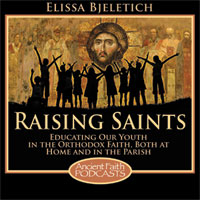
Elissa encourages us to develop a vocabulary to communicate the significance of prayer in terms children can understand and then offer opportunities to put it into practice.
 Transcript
Transcript
Today, we are talking about teaching prayer to children. We need to develop a vocabulary to communicate the significance of prayer in terms that they can understand and apply to their own spiritual lives. And then, we’ll need to offer them opportunities to put it into action. We should pray with them and encourage regular family prayer times.
Now, parents have a lot of control over this. We can personally implement family prayer time. As Sunday School teachers and Youth Ministry leaders, we can train our students about prayer and open their eyes to its meaning and blessings. And we can also send them home with tools to equip their parents to take on family prayer time.
The first question is: How are we teaching what prayer is? We can explain that praying is like talking with God, and children largely understand it. I like to talk with children about Genesis; about the narrative of man’s creation. God makes man in His image, and then talks with him. He creates a beautiful garden for him, offering him all sorts of delightful plants and animals to enjoy.
And even as we discuss man’s fall, we see that Genesis 3:8 reads, “Then, they heard the voice of the Lord God walking in the garden that afternoon.” This was a routine occurrence. Adam and Eve were accustomed to walking with God; enjoying conversation and communion with Him right there in their beautiful home. That’s what prayer is. Prayer is our opportunity to commune with God in the garden. God wishes to spend time with us, and this is how we do it.
Now, on the other hand, it is also important to communicate with children that prayer is not exactly the same as a conversation between people. The very young ones are concrete thinkers, and they can be troubled by the idea that they are talking to God, and He is not answering. They say words and ask questions, and they aren’t getting words back like they think they should. This can be confusing and frustrating, and it can lead them to abandon prayer as a worthless project.
Children need to understand the subtleties of how God communicates with us. And I find that the image that has served me best, both with my own children and in my Sunday School class, has been the soft heart, which we read about in Ezekiel 36:26 where God says, “I shall give you a new heart and put a new spirit within you. I shall take the heart of stone from your flesh and give you a heart of flesh.” We may have hearts of unfeeling stone, but God can replace them with soft hearts of flesh.
Children can easily grasp the idea that our souls have hearts, much like our bodies. Now, this is not the same heart that beats and sends blood to our organs, but it’s the heart that hurts when we’re rejected or lonely. Kids understand whether this heart is hard or soft already, because they’re seeing it on the playground all the time.
Some of their peers are hardhearted, teasing other children and feeling no compassion or sympathy for the pain they cause. Others have softer hearts, which are easily bruised and which ache for people in pain. We can teach our kids to develop softer hearts by using the tools that God gives us – prayer, fasting, attending church services, charity and service work, and study.
In particular, prayer changes hearts. As we spend more and more time in the presence of God, he transforms our hearts from stone to flesh. You might offer them a piece of clay to rub in their warm hands. The clay begins hard and almost solid and impenetrable, like our hearts, but as we work it with our hands, the warmth makes the clay soft and pliable.
God’s warm presence does that for us. It transforms the hardness of our hearts into softness, and just like that clay, our hearts might just grow hard again if we stop praying for awhile. But simply returning to prayer begins to warm us up again. Kids can really hold onto this analogy and understand it. Once they have this concrete image in their minds, we can present them with the key piece of information. A soft heart loves more, feels more, and most importantly is more able to receive God’s love and mercy and His messages.
If we want to walk in the garden with God, we need soft hearts so that those hearts can feel the messages that God sends. Now, this makes a lot of sense, because God is love. And a soft heart really feels love more intensely. Indeed, Christ teaches us to love one another as we love ourselves, and a soft heart has empathy. It feels the pain of others.
Children can understand this concept and make it their own. This idea clarifies the purpose of all sacraments and worship. We spend time in the presence of God in order to soften our hearts that we might feel His presence and live in His love.
Now that we have the concept of prayer and its purpose, we need to give our children the opportunity to practice prayer and to see its effects firsthand. In the Sunday Schools and Youth Ministries, we should be sending home kits and practical tips for making this happen in every family’s home. And as parents, we must be consistently creating family experiences.
Now, of course, most families are already coming together for some evening family prayer time. But here are some ideas to make sure the kids are active participants. Even if we already have a solid tradition working in our homes, it can be invigorating to mix it up a little bit; to introduce something new to bring it alive for our children.
The first obvious questions about family prayer time are when and where? For most families, evening prayers are the logical time to bring the family together for prayer. In some households, this is best done right after dinner. While in others, it’s the last thing to do before the children are tucked in for bed. In a large family like mine, with children spread in age from toddler through middle school, it’s a tricky question. We like to bring our family together for prayers just before the first child heads off to bed, though it will be a few hours before the oldest ones retire.
Once a family has found a good when, they need a good where. And the clear answer is to create an icon corner. Having a small space set aside for prayers is such a beautiful Orthodox tradition. And I love how we literally carve out a space for Christ in our homes. Although of course, He’s welcome throughout the house. But how wonderful to have a sacred space in the home – a space reserved for Him. I think of Christ preparing us rooms in His Father’s mansion, and I smile to think that we’ve prepared Him a room here too.
Now generally speaking, the icon corner is the space where the household keeps its icons – certainly one of Christ and one of His mother, the Theotokos, and then some icons that are special to the family. Perhaps there’s a little table or bookshelf, which holds candles or prayer books and incense. Many people set this up in the parents’ bedroom, which is beautiful because it’s a distinctly private and intimate space, protected from the more public spaces in a home.
On the other hand, in my house, our icon corner is right up front near the entryway. I like that too, because it makes a statement in the public place that this house is dedicated to God. But the real reason we have our prayer space out in the open is because we’re a large family, and we need some elbow room when we gather our five children and two parents for prayers. I also like the idea that the kids can approach the prayer corner at any time day or night, without disturbing the rooms inhabitants.
This icon corner is generally is something that the parents set up and design, so how can we give our kids ownership in it too? For one thing, I think it’s lovely when the kids are able to select some of the icons on the wall. You may wish to hang icons of each of their name’s saints. Now, our family is of Montenegrin heritage in the Serbian Orthodox Church, where we as a family share a patron saint, our Krsna Slava. In our house, that’s St. Luke the Evangelist, so we have an icon of St. Luke or Sveti Luka, as I fondly think of him.
Along with icons of our Lord and Savior Jesus Christ and His holy mother, our intercessor, the Theotokos, we have all sorts of icons up there. Each of our children were allowed to look through some icon catalogs and select their contribution to the icon corner. One chose the Prophet Elias’ ascension in the chariot of fire. Another chose an image of Christ walking on water and reaching out to St. Peter, because she so loved the children’s song on the subject in Gigi Shadid’s Fruits of the Spirit. We have Christ’s creation of the cosmos for my future astronaut, and St. Mary of Egypt for my lion lover. Each child has a special icon up there, because she loved it, and that invites them into real ownership of this space.
Hanging besides those icons, I have a white plate on the wall. I’ve painted some gold crosses on it and divided it into two spaces – one for the living and one for the dead. With dry erase markers, our family is constantly writing names on this plate. Every night when we say our prayers, we read this list of names and ask the Lord’s mercy on them. Throughout the day, my children are comfortable grabbing a marker and adding a name to the plate. I always know who is absent from school as they are sure to be added to the sick and suffering list.
Whenever we see a news report about a deceased celebrity, that name suddenly appears on our list with additional prayers for their family on the living side. My kids are always on the lookout for people who should be on the list. Perhaps the best, way for them to learn intercessory prayer is to do intercessory prayer.
I absolutely recommend that every family have such a list with a pen right there, so that their children can add names in their own hand; writing the names of their friends and loved ones and even strangers in need to lift them up to the Lord in prayer. Whether we’re using an attractive plate or a white board or a pad of paper, we should all have lists available to our children, so that they can request prayers and then see their whole family come together to offer them up.
Another great way to keep children directly involved in the prayers is to think about our prayer books. Kids who can read should have copies of the prayers we’re praying. And in my experience, even the kids who can’t read like to hold books. I like the little blue book, My Orthodox Prayer Book, published by the Greek Orthodox Archdiocese of America Department of Religious Education, as it’s printed in large font, and it uses simple and clear language that children can read and understand. I have enough copies for our whole family on the prayer table, plus a couple of extras for when we have an overnight guest or two.
In addition to the evening prayers we read, I like to select a few other prayers – prayers of thanksgiving or prayers for the sick or the dead; short psalms and neat prayers I found in various places. I print them on index cards. The kids who are old enough to read are welcome to select prayers from this pile and read them during prayer time. In this way, we give them some ownership over our choice of prayers, and we’re also training them to have variety in their prayer life.
I am particularly hopeful that my children will have various prayers memorized (prayers for the sick or the dead, for troubled times, or offered in joyful thanksgiving), so that whenever they need them, whatever happens, they’re always armed with the wise spiritual guidance and nourishment, we find in our rich Orthodox tradition.
These prayers that we read are not just one-way messages sent up to God, but they’re also little lessons in how to approach God; how to think about our struggles and our joys. They teach us the right attitude toward God and toward life, educating us on how to live a good life with God’s love and His peace. We are so blessed with a rich tradition of prayers that simultaneously express our thoughts to God and offer us guidance about how to think about things. Let’s make sure that our children are enjoying this blessing right along side us, and let us hope that they’ll have these words within easy reach whenever they come across a difficult situation or a bump in the road.
So whether you’re a Sunday School teacher offering parents a way to improve their family prayer life or a parent shepherding your own personal flock, let’s take the time to talk about prayer with children. Let’s tell them about how prayer will transform their hearts; how it will soften and warm them so that they can be filled up with God’s love and His mercy.
And then, let’s make sure that they have plenty of opportunities to pray, practicing right alongside their families and teachers. Let’s find ways to make them partners in family prayer routines. Let’s do what we can to equip these smallest saints through a good Orthodox life.



















